![]()
![]()
![]()
Use LEFT and RIGHT arrow keys to navigate between flashcards;
Use UP and DOWN arrow keys to flip the card;
H to show hint;
A reads text to speech;
45 Cards in this Set
- Front
- Back
|
STRUCTURE
Smooth endoplasmic reticulum |
Found in eucaryotes
Function: in nutrient processing, synthesis and storage of nonprotein molecules sup as lips |
|
|
Structure
Flagella |
Found in both eucaryotes and procaryotes
Function: motility |
|
|
Structure
Nucleus |
Found in eucaryotes
Function: Control center. Store cell inheritance (DNA) material and coordinates the cell activities. |
|
|
Structure
Rough endoplasmic reticulum |
Found in eucaryotes
Function: site for protein synthesis |
|
|
Structure
Glycocalyx |
Found in both eucaryotes and procaryotes
Function: adherence, protection,and signal reception |
|
|
Structure
Golgi apparatus |
Found in eucaryotes
Function: packing and modification of protein prior to secretion |
|
|
Structure
Cilia |
Found in eucaryotes
Function: motility and feeding and filtering |
|
|
Structure
Mitochondria Or energy generator or fuel house |
Found in eucaryotes
Function: energy production. |
|
|
Structure
Cell wall |
Found in eucaryotes and procaryotes
Function: support and shape |
|
|
Structure
Plasma membrane |
Found in eucaryotes
Function: protect cells from its surroundings |
|
|
Structure
Nuleolus |
Found in eucaryotes
Function: making proteins in the cell |
|
|
Structure
Chloroplast |
Found in eucaryotes
Function: conversion of sunlight into chemical energy through photosynthesis |
|
|
Structure
Ribosomes |
Found in both eucaryotes and procaryotes
Function: protein synthesis |
|
|
What is the difference between eukaryotic and prokaryotic cells |
Eukaryotic cells have a nucleus
Prokaryotic cells do not have a nucleus |
|
|
What is a Symbiosis? |
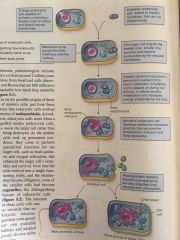
Two or more organisms in a mutual relationship |
|
|
The role of symbiosis in revolution of eukaryotic cells. |
They first appeared a proximately 2 billion years ago
Evidence suggest it evolution from prokaryotic organisms by Symbiosis
Organelle's originated from prokaryotic cells trapped inside them |
|
|
What is the difference between cilia and Flagella? |
Cilia is found only on a single group of Protozoa and certain animals.
flagella Long Sheathed cylinder containing microtubules in a 9 to 2 arrangement |
|
|
Mitochondria how was it evolved, it's structure and function |
Evolved from prokaryotic cells and Endosymbiosis. Consist of an outer membrane and a inner membrane with folds called cristae. Also functions in energy production |
|
|
Where are the nucleolus located ? What are the major responsibilities carried out by the nucleus. |

It is contained within the cells nucleus
It is a dark area for rRNA synthesis and Ribosomes assembly
|
|
|
Protozoans and their important characteristics. |
Very in shape, lack of a cell wall
Some are animal parasite and can be spread by insects vectors
Most have locomotor structures like flagella, Cilia or pseudopods |
|
|
Fungi
2 morphology |
Yeast : single celled, round oval shaped asexual reproduction.
Mold : multicellular, contains multiple identical nuclei, have long filaments known as hyphae. |
|
|
Fungi
Reproduction |
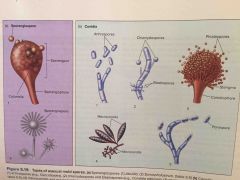
Asexual reproduction: spores are formed through budding or mitosis; conidiophores or sporangiospore.
Sexual reproduction: spores are form following fusion of male and female strains and formation of sexual structure.
Zygospores: One type of sexual spore when male and female unite.
|
|
|
Fungi Importances of spores |
Helps to identify the fungi |
|
|
Fungi
Mycoses |
Fungal infection |
|
|
Fungi
Mycologist |
Person who studies fungal infections or fungi |
|
|
Fungi
Dimorphic |
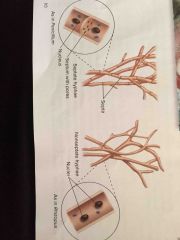
Characteristics of some pathogenic moles
Example: penicillin Marneffei at room temperature, it grows as mold. At body temperature, it grows as a yeast. |
|
|
Fungal Organization |
Filamentous fungus: Mass of hyphae called Mycelium; cottony, hairy, or velvety texture |
|
|
Endoplasm reticulum (ER) |
An interconnected network of membranous, hollow sacs that synthesize and transport cell substance. The ER serves as a passageway for materials between the nucleus and the cytoplasm. It |
|
|
Two types of endoplasmic reticulum and their role |
Rough endoplasmic reticulum : (RER) originates from the outer membrane of the Nuclear envelope and extends through cytoplasm. Rough due to Ribosomes site for protein synthesis
Smooth Endoplasmic Reticulum (SER) : closed tubular network without Ribosomes; Functions the in nutrient processing, synthesis and other storage of protein molecules such as lipids
|
|
|
Internal structure
Golgi apparatus ( Golgi bodies) |
The side of the cell that collects proteins and package them for transport to their final destination. Consist of a stack of flattened sacks with spaces or cisternae. |
|
|
Golgi Apparatus
Functioning, formation of lysosomes |
Transitional vesicles from the ER containing protein go to the Golgi apparatus for modification and maturation
Condensing vesicles transport proteins to organelles such as lysosome( inside the cell) or transported outside the cell as secretory vessels(leaves cell) |
|
|
Internal Structure
Lysosomes |
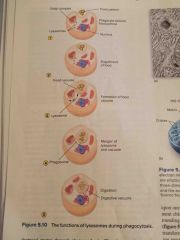
Vesicles containing enzymes(proteins) that originate from Golgi apparatus.
Involved in intracellular digestion of food particles and protection against invading microbes |
|
|
External boundary structures
Cell wall |
rigid, provides structural support and shape. |
|
|
External boundary structure
Fungi |
Have thick inner layer mainly composed of chitin(carbohydrate) |
|
|
External Bandary structure
Algae |
Substance commonly found include cellulose |
|
|
External structure
Glycocalyx (Sugar) |
An outermost boundary that comes into direct contact with environment.
Appears as a network of fibers, A slime layer or capsule
Function in adherence, protection and signal reception |
|
|
Kingdom Protista
Algae |
Most are free living and fresh and marine water (plankton) |
|
|
Kingdom Protista
Plankton |
Small and microscopic organisms drifting or floating in the sea of freshwater. |
|
|
Kingdom Protista
DINOFLAGELLATEs |
Coastal marine species which "bloom" during the warm months of summer. These species reproduce in such great numbers that the water may appear golden or red, producing a "red tide" |
|
|
Internal structure
Chloroplast |
Found in algae and plant cells.
Outer membrane covers inner membrane folds into sacs, thylakoids, stacked into grana.
Larger then mitochondria.
Contains photo synthetic pigments ( chlorophyll).
Convert the energy of sunlight into chemical energy through photosynthesis.
Has Ribosomes 10s and DNA. |
|
|
Internal structure
Importance of Nucleus and its structure |
Control center.
Dark area for rRNA synthesis and ribosomes assembly |
|
|
Important Diseases
T. Cruzi |
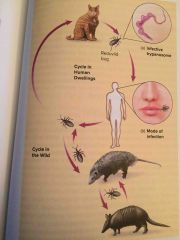
CHaga's disease; South and Central America.
Vector is Reduviid bug or kissing bug
|
|
|
Important diseases
T. Brucei |
African sleeping sickness.
Vector is Tsetse fly |
|
|
Important diseases
Entamoeba histolytic (Amebic Dysentery) |
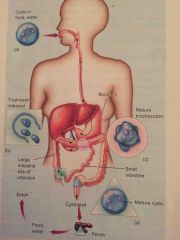
(A) cyst are eaten. (B) Amoebas emerge from cyst. (C) Trophozoites invade the large intestinal wall. (D) mature cyst are released in the feces and may be spread through contaminated food and water |
|
|
|
|

